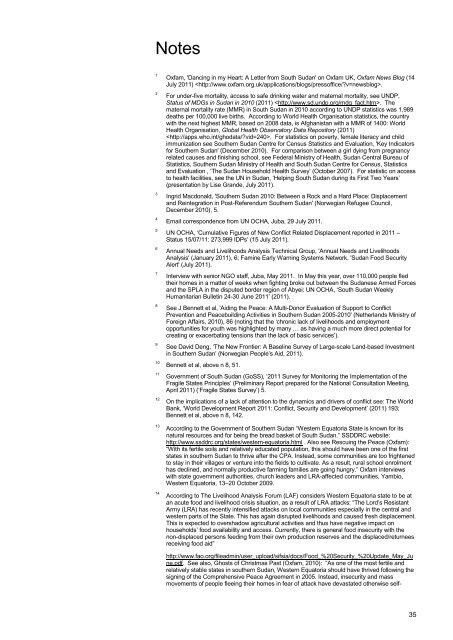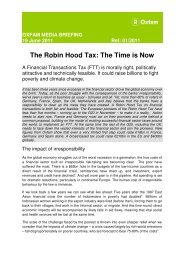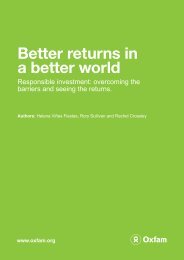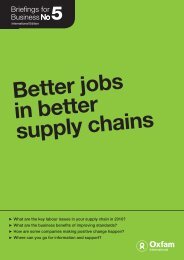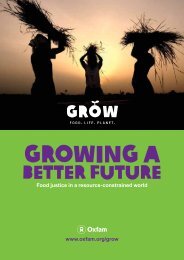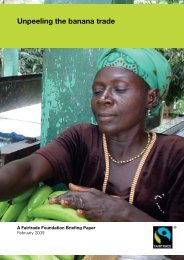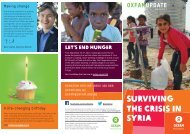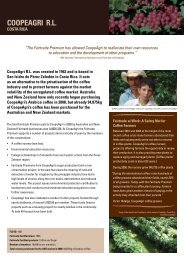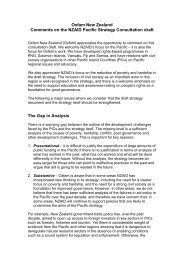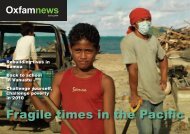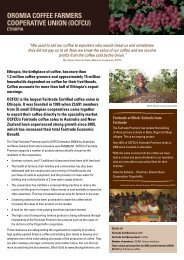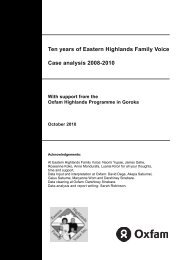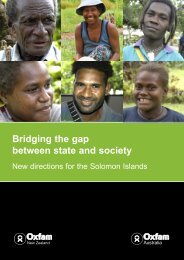Getting it Right from the Start - Oxfam New Zealand
Getting it Right from the Start - Oxfam New Zealand
Getting it Right from the Start - Oxfam New Zealand
You also want an ePaper? Increase the reach of your titles
YUMPU automatically turns print PDFs into web optimized ePapers that Google loves.
Notes1234567891011121314<strong>Oxfam</strong>, 'Dancing in my Heart: A Letter <strong>from</strong> South Sudan' on <strong>Oxfam</strong> UK, <strong>Oxfam</strong> <strong>New</strong>s Blog (14July 2011) .For under-five mortal<strong>it</strong>y, access to safe drinking water and maternal mortal<strong>it</strong>y, see UNDP,Status of MDGs in Sudan in 2010 (2011) . Thematernal mortal<strong>it</strong>y rate (MMR) in South Sudan in 2010 according to UNDP statistics was 1,989deaths per 100,000 live births. According to World Health Organisation statistics, <strong>the</strong> countryw<strong>it</strong>h <strong>the</strong> next highest MMR, based on 2008 data, is Afghanistan w<strong>it</strong>h a MMR of 1400: WorldHealth Organisation, Global Health Observatory Data Repos<strong>it</strong>ory (2011). For statistics on poverty, female l<strong>it</strong>eracy and childimmunization see Sou<strong>the</strong>rn Sudan Centre for Census Statistics and Evaluation, 'Key Indicatorsfor Sou<strong>the</strong>rn Sudan' (December 2010). For comparison between a girl dying <strong>from</strong> pregnancyrelated causes and finishing school, see Federal Ministry of Health, Sudan Central Bureau ofStatistics, Sou<strong>the</strong>rn Sudan Ministry of Health and South Sudan Centre for Census, Statisticsand Evaluation , „The Sudan Household Health Survey‟ (October 2007). For statistic on accessto health facil<strong>it</strong>ies, see <strong>the</strong> UN in Sudan, „Helping South Sudan during <strong>it</strong>s First Two Years‟(presentation by Lise Grande, July 2011).Ingrid Macdonald, 'Sou<strong>the</strong>rn Sudan 2010: Between a Rock and a Hard Place: Displacementand Reintegration in Post-Referendum Sou<strong>the</strong>rn Sudan' (Norwegian Refugee Council,December 2010), 5.Email correspondence <strong>from</strong> UN OCHA, Juba, 29 July 2011.UN OCHA, „Cumulative Figures of <strong>New</strong> Conflict Related Displacement reported in 2011 –Status 15/07/11: 273,999 IDPs‟ (15 July 2011).Annual Needs and Livelihoods Analysis Technical Group, 'Annual Needs and LivelihoodsAnalysis' (January 2011), 6; Famine Early Warning Systems Network, 'Sudan Food Secur<strong>it</strong>yAlert' (July 2011).Interview w<strong>it</strong>h senior NGO staff, Juba, May 2011. In May this year, over 110,000 people fled<strong>the</strong>ir homes in a matter of weeks when fighting broke out between <strong>the</strong> Sudanese Armed Forcesand <strong>the</strong> SPLA in <strong>the</strong> disputed border region of Abyei: UN OCHA, „South Sudan WeeklyHuman<strong>it</strong>arian Bulletin 24-30 June 2011‟ (2011).See J Bennett et al, 'Aiding <strong>the</strong> Peace: A Multi-Donor Evaluation of Support to ConflictPrevention and Peacebuilding Activ<strong>it</strong>ies in Sou<strong>the</strong>rn Sudan 2005-2010' (Ne<strong>the</strong>rlands Ministry ofForeign Affairs, 2010), 86 (noting that <strong>the</strong> ‘chronic lack of livelihoods and employmentopportun<strong>it</strong>ies for youth was highlighted by many … as having a much more direct potential forcreating or exacerbating tensions than <strong>the</strong> lack of basic services‟).See David Deng, „The <strong>New</strong> Frontier: A Baseline Survey of Large-scale Land-based Investmentin Sou<strong>the</strong>rn Sudan‟ (Norwegian People‟s Aid, 2011).Bennett et al, above n 8, 51.Government of South Sudan (GoSS), „2011 Survey for Mon<strong>it</strong>oring <strong>the</strong> Implementation of <strong>the</strong>Fragile States Principles‟ (Preliminary Report prepared for <strong>the</strong> National Consultation Meeting,April 2011) („Fragile States Survey‟) 5.On <strong>the</strong> implications of a lack of attention to <strong>the</strong> dynamics and drivers of conflict see: The WorldBank, „World Development Report 2011: Conflict, Secur<strong>it</strong>y and Development‟ (2011) 193;Bennett et al, above n 8, 142.According to <strong>the</strong> Government of Sou<strong>the</strong>rn Sudan “Western Equatoria State is known for <strong>it</strong>snatural resources and for being <strong>the</strong> bread basket of South Sudan.” SSDDRC webs<strong>it</strong>e:http://www.ssddrc.org/states/western-equatoria.html . Also see Rescuing <strong>the</strong> Peace (<strong>Oxfam</strong>):“W<strong>it</strong>h <strong>it</strong>s fertile soils and relatively educated population, this should have been one of <strong>the</strong> firststates in sou<strong>the</strong>rn Sudan to thrive after <strong>the</strong> CPA. Instead, some commun<strong>it</strong>ies are too frightenedto stay in <strong>the</strong>ir villages or venture into <strong>the</strong> fields to cultivate. As a result, rural school enrolmenthas declined, and normally productive farming families are going hungry.” <strong>Oxfam</strong> interviewsw<strong>it</strong>h state government author<strong>it</strong>ies, church leaders and LRA-affected commun<strong>it</strong>ies, Yambio,Western Equatoria, 13–20 October 2009.According to The Livelihood Analysis Forum (LAF) considers Western Equatoria state to be atan acute food and livelihood crisis s<strong>it</strong>uation, as a result of LRA attacks: “The Lord‟s ResistantArmy (LRA) has recently intensified attacks on local commun<strong>it</strong>ies especially in <strong>the</strong> central andwestern parts of <strong>the</strong> State. This has again disrupted livelihoods and caused fresh displacement.This is expected to overshadow agricultural activ<strong>it</strong>ies and thus have negative impact onhouseholds‟ food availabil<strong>it</strong>y and access. Currently, <strong>the</strong>re is general food insecur<strong>it</strong>y w<strong>it</strong>h <strong>the</strong>non-displaced persons feeding <strong>from</strong> <strong>the</strong>ir own production reserves and <strong>the</strong> displaced/returneesreceiving food aid”http://www.fao.org/fileadmin/user_upload/sifsia/docs/Food_%20Secur<strong>it</strong>y_%20Update_May_June.pdf. See also, Ghosts of Christmas Past (<strong>Oxfam</strong>, 2010): “As one of <strong>the</strong> most fertile andrelatively stable states in sou<strong>the</strong>rn Sudan, Western Equatoria should have thrived following <strong>the</strong>signing of <strong>the</strong> Comprehensive Peace Agreement in 2005. Instead, insecur<strong>it</strong>y and massmovements of people fleeing <strong>the</strong>ir homes in fear of attack have devastated o<strong>the</strong>rwise self-35


